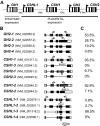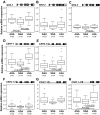Differential expression profile of growth hormone/chorionic somatomammotropin genes in placenta of small- and large-for-gestational-age newborns
- PMID: 20233782
- PMCID: PMC2869554
- DOI: 10.1210/jc.2010-0023
Differential expression profile of growth hormone/chorionic somatomammotropin genes in placenta of small- and large-for-gestational-age newborns
Abstract
Context: The human growth hormone/chorionic somatomammotropin (hGH/CSH) locus at 17q22-24, consisting of one pituitary-expressed postnatal (GH1) and four placenta-expressed genes (GH2, CSH1, CSH2, and CSHL1), is implicated in regulation of postnatal and intrauterine growth. A positive correlation has been reported between the offspring's birth weight and serum placental GH (coded by GH2) and placental lactogen (coded by CSH1, CSH2) levels in pregnant women.
Objective: The objective of the study was the investigation of the hypothesis that the mRNA expression profile of placental hGH/CSH genes contributes to the determination of birth weight.
Design and subjects: We developed a sensitive, fluorescent-labeled semiquantitative RT-PCR assay coupled with gene-specific restriction analysis, capable of distinguishing alternative splice-products of individual placental hGH/CSH genes and quantification of their relative expression levels. The detailed profile of alternative transcripts of GH2, CSH1, CSH2, and CSHL1 genes in placenta from uncomplicated term pregnancies of the REPROMETA sample collection was addressed in association with the birth weight of newborns, grouped as appropriate for gestational age (AGA; n = 23), small for gestational age (SGA; n = 15), and large for gestational age (LGA; n = 34).
Results: The majority of pregnancies with SGA newborn showed down-regulation of the entire hGH/CSH cluster in placenta, whereas in the case of LGA, the expression of CSH1-1, CSH2-1, and CSHL1-4 mRNA transcripts in placenta was significantly increased compared with AGA newborns (P < 0.0001, P = 0.009, P = 0.002, respectively).
Conclusion: The expression profile of placental hGH/CSH genes in placenta is altered in pregnancies accompanied by SGA and LGA compared with AGA newborns, and thus, it may directly affect the circulating fetal and maternal placental GH and placental lactogen levels.
Figures




Comment in
-
Placental hormones and the control of fetal growth.J Clin Endocrinol Metab. 2010 May;95(5):2054-7. doi: 10.1210/jc.2010-0517. J Clin Endocrinol Metab. 2010. PMID: 20444932 No abstract available.
References
-
- George DL, Phillips 3rd JA, Francke U, Seeburg PH 1981 The genes for growth hormone and chorionic somatomammotropin are on the long arm of human chromosome 17 in region q21 to qter. Hum Genet 57:138–141 - PubMed
-
- Handwerger S, Freemark M 2000 The roles of placental growth hormone and placental lactogen in the regulation of human fetal growth and development. J Pediatr Endocrinol Metab 13:343–356 - PubMed
-
- Chen EY, Liao YC, Smith DH, Barrera-Saldaña HA, Gelinas RE, Seeburg PH 1989 The human growth hormone locus: nucleotide sequence, biology, and evolution. Genomics 4:479–497 - PubMed
-
- Hirt H, Kimelman J, Birnbaum MJ, Chen EY, Seeburg PH, Eberhardt NL, Barta A 1987 The human growth hormone gene locus: structure, evolution, and allelic variations. DNA 6:59–70 - PubMed
Publication types
MeSH terms
Substances
Grants and funding
LinkOut - more resources
Full Text Sources
Miscellaneous

